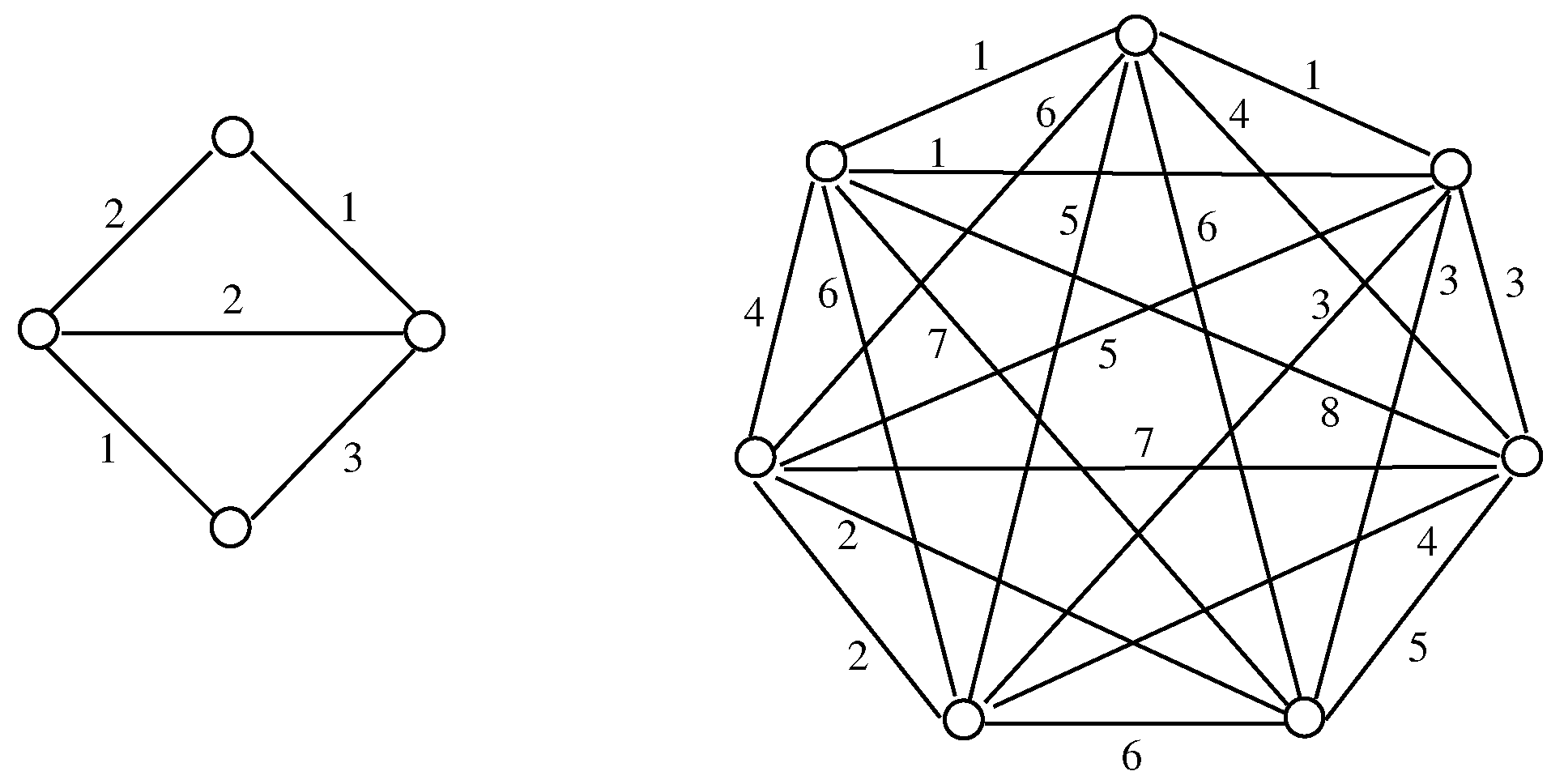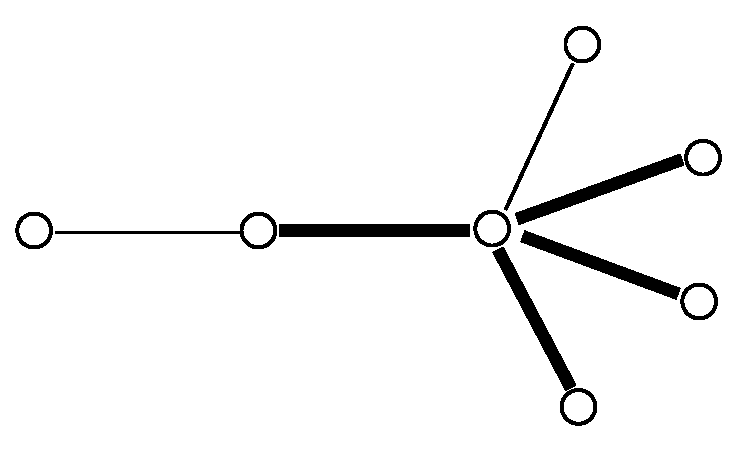The Ascending Ramsey Index of a Graph
Abstract
:1. Introduction
Is there also a partition of S into k subsets such that for with the added property that either or for each integer i with ?
Let S be a set with such that for some integer and let be a partition of S into two subsets. Then, there exist k pairwise disjoint subsets of S such that for and either or for each integer i with .
Let S be a set with where for some integer such that there is some prescribed structure among the elements of S. If is a partition of S into two subsets, do there exist k pairwise disjoint subsets of S such that (1) for , (2) either or for each integer i with , and (3) for each integer i with , there is a substructure of elements of identical with that of ? If there exists no such k subsets of S with these properties, then what is the maximum number of pairwise disjoint subsets of S having all three properties?
2. Ascending Subgraph Sequences
3. Ascending Ramsey Sequences
4. Complete Graphs
5. Matchings and Stars
- 🟉
- If , then let .
- 🟉
- If , then let .
6. Double Stars
- 🟉
- If , then and so is a star. Thus, is star. Since , this is a contradiction.
- 🟉
- If , then and so is a star. Thus, is a star. Since , this is a contradiction.
- (1)
- Both and appear in every ascending Ramsey sequence of length k in F;
- (2)
- One of and does not appear in some ascending Ramsey sequences of length k in F.
- (A)
- If or , say the former, then we can interchange e and to produce a new ascending Ramsey sequence of length k in F that does not contain , which is impossible in this case. Thus, for and so .
- (B)
- If , or , or , then this sequence is also an ascending Ramsey sequence in G. Therefore, we can assume that
- (C)
- If where and , then we can interchange and to produce and in G. Therefore, we can assume that .
- 🟉
- First, suppose that the missing edge . Since g is red, it follows by (A) that is red and is blue. We construct in G with and in G with .
- 🟉
- Next, suppose that the missing edge . First, let us suppose that is red. Since the red edge g appears in this sequence, say where , we can interchange g and to produce , , and an ascending Ramsey sequence of length k in G. Next, suppose that is blue. Therefore, and are red. Then, we construct in G with , in G with , and in G with . Thus, in this situation as well, there is an ascending Ramsey sequence of length k in G.
- 🟉
- First, suppose that is red. Let q be the largest integer in such that is blue. Since is red, it follows that is red. Let . We define in G with , in G with , in G with , and in G with .
- 🟉
- Next, suppose that is blue.
- ⚬
- If is blue, then we define in G with , in G with , in G with . Thus, we may assume that is red. Thus, .
- ⚬
- If is blue, then we define in G with , in G with where , in G with . Here, z is the missing edge. Thus, we may assume that is red. Thus, .
Let q be the largest integer in such that is blue. Since is red, it follows that is red. Let . We define in G with , in G with , in G with , and in G with . The edge e remains the missing edge.
- 🟉
- First, suppose that is blue with . Define with , in G with , and in G with .
- 🟉
- Next, let us suppose that is red. Let q be the largest integer in such that is red. If , then we define in G with and in G with . If , then is blue. Let us define in G with , in G with where , and in G with .
- (D)
- If , say , then we can define in G with , in G with , and in G with . Thus, we can assume that and so .
- 🟉
- If , say or , then we define in G with and in G with , producing an ascending Ramsey sequence of length k in G.
- 🟉
- If where , then we construct a new ascending Ramsey sequence , , …, of length k in F by defining with where , with , and if and . Thus, where . The argument used in Subcase 1.1.2 shows that there is an ascending Ramsey sequence of length k in G.
- (E)
- If or , then this sequence is also an ascending Ramsey sequence of length k in G. Thus, we may assume that and .
- (F)
- If where and , then we can interchange z and to produce an ascending Ramsey sequence of length k in G. Thus, we may assume that .
- 🟉
- First, let us suppose that . Let where . Since , we can define with , with , and with , producing an ascending Ramsey sequence of length k in G where for .
- 🟉
- Next, let us suppose that . Let us recall that where z is the missing edge. Let . We now interchange e and z such that and e is the missing edge in the new ascending Ramsey sequence of length k in G where for . Hence, where and (which are the conditions in the proof of Subcase 1.1.2). Therefore, the argument used in Subcase 1.1.2 shows that there is an ascending Ramsey sequence of length k in G.
- 🟉
- First, let us suppose that . Then, where by (E). Let where . If , then we can define and in G with . Thus, we may assume that and so . If , then we can define with , , and is the missing edge. If where , then we can define , , , and is the missing edge.
- 🟉
- Next, suppose that . We may assume that is blue and is red (since the proof for the situation when is red and is blue is the same by interchanging red and blue). Let us recall that is blue and is red. Let be the maximum integer such that is blue. Thus, is red where possibly . Let . We now define with , with , with , and with .
- 🟉
- If , then .
- 🟉
- If , then .
Author Contributions
Funding
Data Availability Statement
Acknowledgments
Conflicts of Interest
References
- Ali, A.; Chartrand, G.; Zhang, P. Irregularity in Graphs; Springer: New York, NY, USA, 2021. [Google Scholar]
- Alavi, Y.; Boals, A.J.; Chartrand, G.; Erdos, P.; Oellermann, O.R. The ascending subgraph decomposition problem. Congr. Numer. 1987, 58, 7–14. [Google Scholar]
- Cao, Y.; Chen, G.; Jing, G.; Stiebitz, M.; Toft, B. Graph edge coloring: A survey. Graphs Combin. 2019, 35, 33–66. [Google Scholar] [CrossRef]
- Liang, Z.; Fu, H.L. On ascending subgraph decomposition of graphs. J. Discrete Math. Sci. Cryptogr. 2017, 20, 1135–1149. [Google Scholar] [CrossRef]
- Ramsey, F.P. On a problem of formal logic. Proc. Lond. Math. Soc. 1930, 30, 264–286. [Google Scholar] [CrossRef]
- Beineke, L.W.; Wilson, R.L. (Eds.) Topics in Chromatic Graph Theory; Encyclopedia of Mathematics and Its Applications; Cambridge University Press: Cambridge, UK, 2015. [Google Scholar]
- Chartrand, G.; Zhang, P. New directions in Ramsey theory. Discrete Math. Lett. 2021, 6, 84–96. [Google Scholar]
- Gallian, J.A. A dynamic survey of graph labeling. Electron. J. Combin. 2014, 17, DS6. [Google Scholar] [CrossRef] [PubMed]
- Haryeni, D.O.; Awanis, Z.Y.; Bača, M.; Semaničová-Feňciková, A. Modular version of edge irregularity strength for fans and wheels graphs. Symmetry 2022, 14, 2671. [Google Scholar] [CrossRef]



Disclaimer/Publisher’s Note: The statements, opinions and data contained in all publications are solely those of the individual author(s) and contributor(s) and not of MDPI and/or the editor(s). MDPI and/or the editor(s) disclaim responsibility for any injury to people or property resulting from any ideas, methods, instructions or products referred to in the content. |
© 2023 by the authors. Licensee MDPI, Basel, Switzerland. This article is an open access article distributed under the terms and conditions of the Creative Commons Attribution (CC BY) license (https://creativecommons.org/licenses/by/4.0/).
Share and Cite
Chartrand, G.; Zhang, P. The Ascending Ramsey Index of a Graph. Symmetry 2023, 15, 523. https://doi.org/10.3390/sym15020523
Chartrand G, Zhang P. The Ascending Ramsey Index of a Graph. Symmetry. 2023; 15(2):523. https://doi.org/10.3390/sym15020523
Chicago/Turabian StyleChartrand, Gary, and Ping Zhang. 2023. "The Ascending Ramsey Index of a Graph" Symmetry 15, no. 2: 523. https://doi.org/10.3390/sym15020523
APA StyleChartrand, G., & Zhang, P. (2023). The Ascending Ramsey Index of a Graph. Symmetry, 15(2), 523. https://doi.org/10.3390/sym15020523





